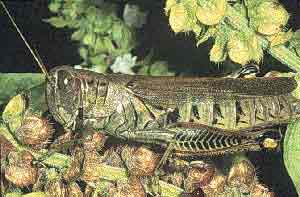
Kentucky's three common grasshopper species overwinter in the egg stage. Laid in masses of 20 to 130 eggs, they are placed in packets below the soil surface. Generally, eggs are laid in uncultivated ground in the fall and begin to hatch the following spring. There is typically only one generation per year.
Treat after cutting when plants are less than six inches tall if more than 15 grasshoppers per square yard are found in the field. Perimeter treatments should be made if more than 40 grasshopper adults or nymphs per square yard are observed on the field margins.
| Insecticide | Rate per Acre | Harvest or Graze (days) |
| Baythroid 2 | 2.0 - 2.8 fl oz | 7 |
| Malathion 57% EC | 1-1/2 to 2 pts | 0 |
| Dimethoate E267 | 3/4 to 1-1/2 pt | 10 |
| Furadan 4F (carbofuran) | 1/4 to 1/2 pt | 7 |
| Guthion 3 F (azinphos methyl) | 1-1/3 to 2 pts | 21 |
| Lorsban 4E (chlorpyrifos) | 1/2 to 1 pts | 1/2 pt = 7 1 pt = 14) |
| Mustang Max | 2.8 to 4 fl oz | 3 |
| Sevin 4F (carbaryl) | 1/2 to1-1/2 qts | 7 |
| Sniper 50 PVA | 1 - 1-1/2 lb | 1/2 to 3/4 lb = 14 1 lb = 16 above 1 lb = 21 |
| Warrior 1 CS (lambda-cyhalothrin) | 2.56 to 3.84 fl oz | forage = 1 hay = 7 |
| Insecticide | Rate per Acre | Harvest or Graze (days) | Notes |
| Bt products* | See label | 0 | Armyworms only |
| Cythion 57% EC | 1-1/2 to 2 pts | 0 | Use 2 pts for armyworms |
| Orthene 75S | 1/8 to 1/6 lb | 21 | Grasshoppers only |
| Sevin 4F | 1 to 1-1/2 qts | 0 - aerial, 14 - ground | |
| Sevin 80S | 1-1/4 to 1-7/8 lbs | 0 - aerial, 14 - ground | |
* Agree, Biobit, Dipel 2X, and Javelin.